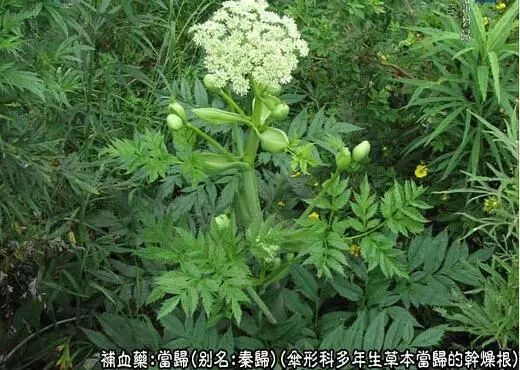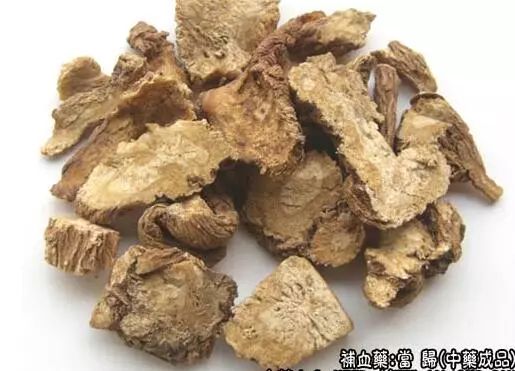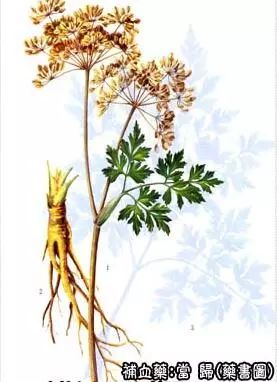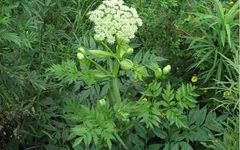Disease Inquiry, Health Guidance, Classic Health Preservation, Traditional Chinese Medicine and Herbs, Seeking Help for Illness



Angelica Sinensis (Dang Gui) is a commonly used traditional Chinese medicine. It was first recorded in the Shen Nong Ben Cao Jing (Shen Nong’s Classic of Materia Medica) and is classified as a medium-grade herb.
Alias: Qin Gui, Xi Gui, Gan Gui, Ma Wei Dang Gui, Qin Na, Ma Wei Gui, Yun Gui, Xi Dang Gui, Min Dang Gui
Source: The root of the plant Angelica sinensis, belonging to the Apiaceae family. It generally requires three years of cultivation before harvesting. The roots are dug up in late autumn, cleaned of stems and soil, and air-dried in a ventilated place for several days. They are then bundled according to size and lightly smoked to ensure thorough drying. This herb is oily and prone to mold and insect damage, so it must be stored in a dry place. During moldy and rainy seasons, it should be treated with sulfur or appropriately dried.
Origin: Mainly produced in areas such as Min County, Dangchang, Wudu, Xihe, Lixian, and Wushan in Gansu Province; also produced in Yunnan, Sichuan, Shaanxi, Hubei, and Guizhou.
Identification: The main root is cylindrical or conical, with several to over ten lateral roots that are slightly twisted. The total length is 10-25 cm, with the main root measuring 2-7 cm in length and 2-3 cm in diameter, sometimes reaching 3.5 cm at the top. The upper end of the lateral roots is about 1 cm in diameter, tapering towards the end. The top has a distinct base scar, which is slightly raised or flat, often with remnants of the base leaves. The skin is brownish or light brown, with the upper end of the main root having indistinct ring-like wrinkles, and the entire root has tight longitudinal wrinkles and slightly raised pores. It is hard, and when it absorbs moisture, it becomes soft and tough, with a cross-section that is yellowish-white or light yellow-brown, exhibiting a radial texture, commonly referred to as “Chrysanthemum Heart”. The cambium is dark brown and ring-shaped. The xylem and phloem contain numerous small fissures and yellow-brown secretion cavities, with a white pith sometimes present in the center. It has a distinctive aromatic scent and a slightly bitter and spicy taste.
The best quality is characterized by a long, thick main root, few but robust lateral roots, and a yellow-brown surface with a powdery white or light yellow-white cross-section.
Main Components: Contains volatile oils and a component that stimulates the uterus; also contains sucrose, vitamin B12, etc.
Preparation: For Dang Gui: Remove impurities, wash clean, moisten, and slightly dry until the internal and external moisture is suitable, then slice and dry in the sun. For wine Dang Gui: Take Dang Gui slices, evenly spray with yellow wine, slightly moisten, then stir-fry in a pot over low heat, remove, and cool (100 jin of Dang Gui slices with 10 jin of yellow wine).
Storage: Store in a cool, dry place, protecting from moisture and insects.
Effects and Functions: Nourishes blood, promotes blood circulation, moistens the intestines, regulates menstruation.
1. Adjusts uterine function. Animal experiments have confirmed that when the uterus is under internal pressure, Dang Gui has a stimulating effect, making uterine contractions shift from irregular to regular, with increased contraction strength; when there is no internal pressure, Dang Gui has an inhibitory effect on the uterus.
2. Sedative and analgesic effects. The effective component is volatile oil.
3. Diuretic effect. The effective component is sucrose.
4. Anti-vitamin E deficiency.
5. Antibacterial effects. In vitro tests show inhibitory effects on dysentery bacillus, typhoid bacillus, E. coli, and hemolytic streptococcus.
Taste and Properties: Sweet, bitter, spicy, warm.
Meridians Entered: Heart, Liver, Spleen.
Functions: Nourishes blood, invigorates blood circulation, regulates menstruation, moistens dryness, and promotes bowel movements.
Indications: Irregular menstruation, amenorrhea with abdominal pain, masses and accumulations, excessive bleeding; blood deficiency headaches, dizziness, weakness; dry intestines and difficult bowel movements, post-dysentery fatigue; carbuncles and sores, trauma from falls.
Clinical Applications: Dang Gui is one of the most commonly used herbs in TCM. It is used for nourishing blood and promoting circulation, applicable to blood deficiency, deficiency syndromes, exterior syndromes, and abscesses.
1. A key herb in gynecology, primarily used for regulating menstruation, with good efficacy for dysmenorrhea, often combined with Bai Shao (White Peony) and Yan Hu Suo (Corydalis). It also treats amenorrhea and irregular menstruation. In summary, various menstrual regulation formulas cannot do without Dang Gui, which has blood-moving and analgesic effects (either enhancing uterine contractions to expel stagnant blood or relaxing uterine spasms to relieve pain), often combined with Shu Di Huang (Rehmannia), Chuan Xiong (Ligusticum), and Bai Shao to form the Si Wu Decoction. This is a fundamental formula for regulating blood, suitable not only for blood deficiency but also for various syndromes of irregular menstruation and postpartum conditions, which can generally be adjusted based on this formula.
2. Used for nourishing blood. For symptoms of heart blood deficiency such as palpitations, forgetfulness, insomnia, and anxiety, Dang Gui nourishes blood to calm the spirit, as in the Dang Gui Bu Xue Decoction; for symptoms of spleen blood deficiency leading to emaciation and sallow complexion, Dang Gui nourishes blood to strengthen the spleen, as in the Si Wu Decoction; for symptoms of liver blood deficiency causing dizziness, tinnitus, and muscle spasms, Dang Gui nourishes blood to soften the liver, as in the Yi Guan Jian.
3. Used to treat blood stasis in the limbs, especially for trauma and vascular diseases causing blood stasis or poor circulation and swelling, Dang Gui has a stasis-resolving effect (improving circulation and relieving pain), thus commonly used in trauma formulas and those for treating thrombotic occlusive vascular diseases.
4. Used to treat abdominal pain, particularly suitable for pain due to qi and blood stasis combined with deficiency and cold, such as postpartum abdominal pain, often combined with Jian Zhong Tang to enhance warming and pain-relieving effects, as in the Dang Gui Jian Zhong Tang, or Dang Gui Sheng Jiang Yang Rou Tang; if the pain is more due to stasis (e.g., early dysentery with bloody diarrhea and abdominal pain or constipation-related abdominal pain in women), it can be combined with Bai Shao and Xiang Fu for blood-moving and analgesic effects, as in the Dang Gui Shao Yao San with modifications.
5. Used to treat chronic carbuncles, leveraging its blood-invigorating, blood-nourishing, and pain-relieving properties to improve circulation and enhance the body’s resistance, often combined with Huang Qi (Astragalus) and Yin Hua (Honeysuckle).
6. Used to treat dry intestines and constipation, particularly suitable for those with qi and blood deficiency, often combined with other herbs that nourish and promote bowel movements, such as Rou Cong Rong (Cistanches) and Niu Xi (Achyranthes), as in the Ji Chuan Jian.
Additionally, for exterior syndromes with qi and blood deficiency, or headaches and joint pain due to blood stasis, Dang Gui can also be used for its blood-moving and analgesic effects.
Dosage: The common dosage is 9-12 g, but a slightly larger amount is recommended, ranging from 12-30 g, and in large doses, it can be used up to 60 g. For exterior syndromes, a small amount of 3-9 g is sufficient; for nourishing blood and improving circulation and constipation, such as in the Dang Gui Sheng Jiang Yang Rou Tang for postpartum blood deficiency, the dosage of Dang Gui is usually above 30 g, while in the Dang Gui Bu Xue Tang, only 6 g of Dang Gui is used to assist Huang Qi (this formula is named “Nourishing Blood” but actually nourishes qi to generate blood).
Precautions:
1. It has been said: “The head of Dang Gui nourishes blood, the body nourishes blood, and the tail breaks blood, all are used for invigorating blood”; or “The head nourishes the head (including neck and chest), the body nourishes the body, and the tail nourishes the limbs”. However, in practice, it is not necessary to be rigid. In clinical applications, the commonly sold Dang Gui is generally supplied as whole roots. If conditions permit, it can be subdivided according to the following principles: for improving blood circulation or when used in exterior-releasing formulas, whole Dang Gui is better; for treating anemia and regulating menstruation, the body of Dang Gui is preferable; for treating trauma and joint stiffness, the tail of Dang Gui is better.
2. Long-term or excessive use of Dang Gui may cause deficiency fire to rise, leading to symptoms such as throat pain and nasal burning; in such cases, it is advisable to add cooling and blood-clearing herbs, such as Yin Hua and Sheng Di to adjust.
3. Dang Gui promotes bowel movements, so it is not suitable for those with spleen and stomach yang deficiency leading to diarrhea; if one usually has loose stools and needs to use Dang Gui, it is advisable to add Bai Zhu (Atractylodes) and Fu Ling (Poria) to counteract the laxative effect of Dang Gui.
4. Dang Gui is warm in nature, so it is not suitable for those with lung deficiency and internal heat, or those who have just stopped vomiting blood.
Example Formulas:
1. Dang Gui Bu Xue Tang (Discussion on Internal and External Injuries): Dang Gui 6 g, Huang Qi 30 g, decoct in water for oral administration.
2. Yi Guan Jian (Liuzhou Medical Talk): Dang Gui body 9 g, Bei Sha Shen 9 g, Mai Dong 6 g, Sheng Di 24 g, Qi Zi 12 g, Chuan Lian Zi 4.5 g, decoct in water for oral administration.
3. Dang Gui Jian Zhong Tang (Qian Jin Yi Fang): Dang Gui 12 g, Gui Zhi 6 g, Bai Shao 12 g, Fen Gan Cao 9 g, Sheng Jiang 3 g, Hong Zao 15 g, Yi Tang 30 g (dissolved), decoct in water for oral administration.
4. Dang Gui Sheng Jiang Yang Rou Tang (Jin Kui Yao Lue): Lamb 250 g, Dang Gui 30 g, Sheng Jiang 15 g, steam in water, serve warm, or decoct in water for oral administration.
5. Dang Gui Shao Yao San with modifications: Dang Gui 9 g, Bai Shao 12 g, Chuan Xiong 6 g, Bai Zhu 9 g, Fu Ling 9 g, Ze Xie 9 g, Xiang Fu 6 g, Yan Hu Suo 6 g, decoct in water for oral administration.
6. Ji Chuan Jian (Jing Yue Quan Shu): Dang Gui 12 g, Niu Xi 6 g, Xian Rou Cong Rong, Ze Xie 4.5 g, Sheng Ma 2.4 g, Zhi Ke 3 g, decoct in water for oral administration.
Note: The product specifications have varied in the past, such as Hu Shou Gui, Yuan Lai Tou, Chang Xing Gui, Gui Tui, Gui Wei, etc. They are now simplified into grades 1-4 for Dang Gui and grades 1-4 for the head of Dang Gui, classified by the size of the roots. Grade 1 Dang Gui has 20 roots per 0.5 kg or less, grade 2 has 33 roots or less, grade 3 has 55 roots or less, and grade 4 has more than 55 roots, with no more than 70% of the tail. The head of Dang Gui (Hu Shou) has grade 1 with 20 roots or less, grade 2 with 40 roots or less, grade 3 with 60 roots or less, and grade 4 with 80 roots or less.
This product from Gansu has better quality, with long main roots, fine skin, and solid texture. The product from Yunnan has short, thick main roots, coarser skin, and a slightly inferior quality. Additionally, some regions also produce local Dang Gui for local sale.
Note: This article is for reference only; please follow medical advice for specific treatment and medication!This public account is only for academic exchange.
Want to learn more about TCM, Chinese herbs, herbal remedies, and folk prescriptions? ▼ Click the card below ▼ to inquire!
For example: back pain, gynecology, andrology, kidney tonification, lumbar disc herniation, back pain, leg pain, knee pain, cervical spondylosis, liver disease, stomach disease, constipation, frequent urination, diarrhea, abdominal protrusion, dysmenorrhea, mammary gland hyperplasia, postpartum care, acne, white hair, hair loss, skin diseases, age spots, aging, yin deficiency, cold, cough, fever, insomnia, stones, pharyngitis, sore throat, headache, toothache, snoring, oral ulcers, bad breath, rhinitis, tinnitus, eye diseases, thyroid issues, dandruff, athlete's foot, hemorrhoids, cold hands and feet, rheumatism, night sweats, cerebral hemorrhage, hypertension, diabetes, asthma, heart disease, cardiovascular diseases, fatty liver, gout, dementia, varicose veins, qi tonification, blood tonification, calcium supplementation, weakness, obesity, pediatric diseases, slim legs, slim waist, dampness, spleen strengthening, hiccups, body odor, cramps, smoking cessation, meridians, Chinese patent medicines, foot baths... and more.
Thank you for sharing and clicking "See" for continuous good fortune.

